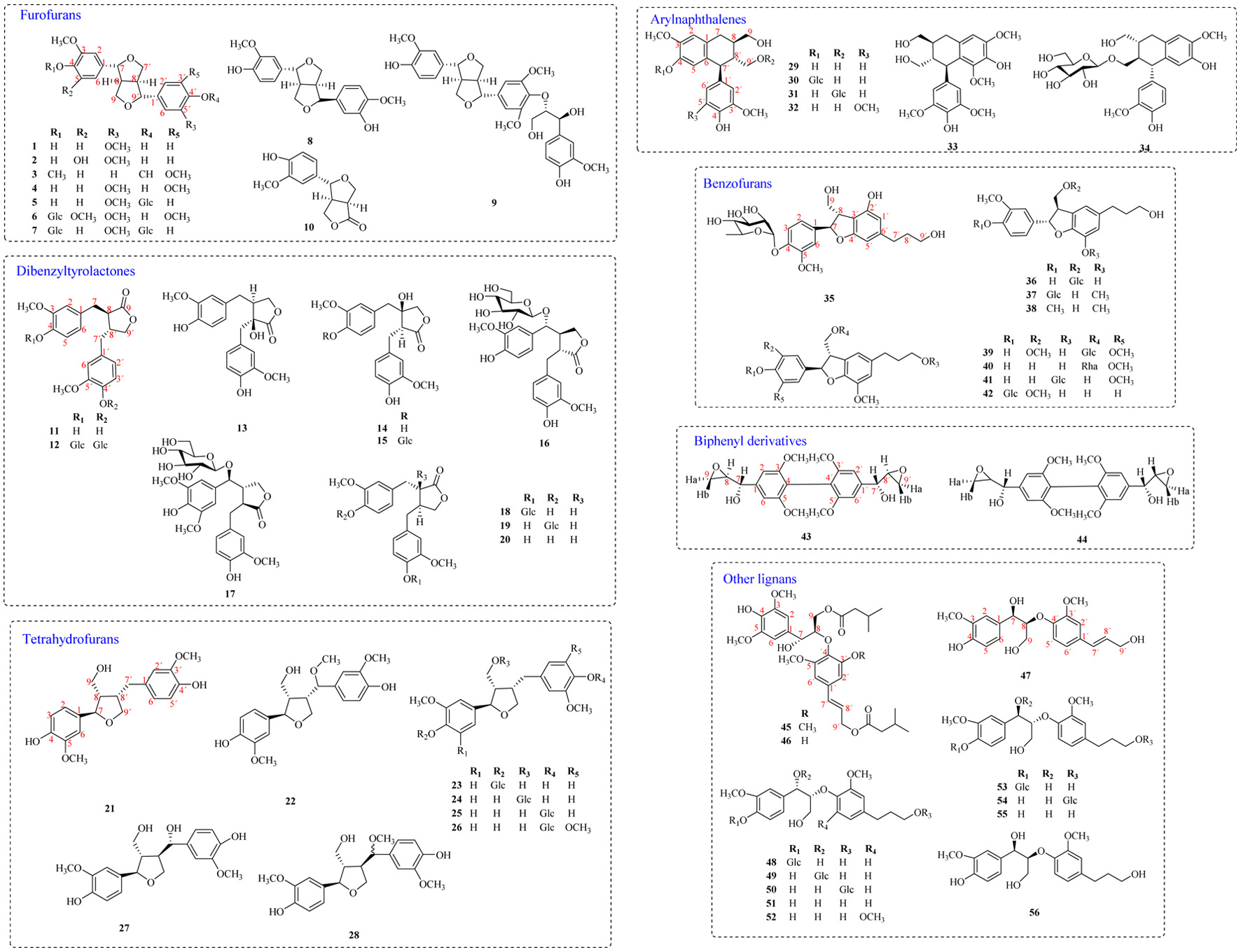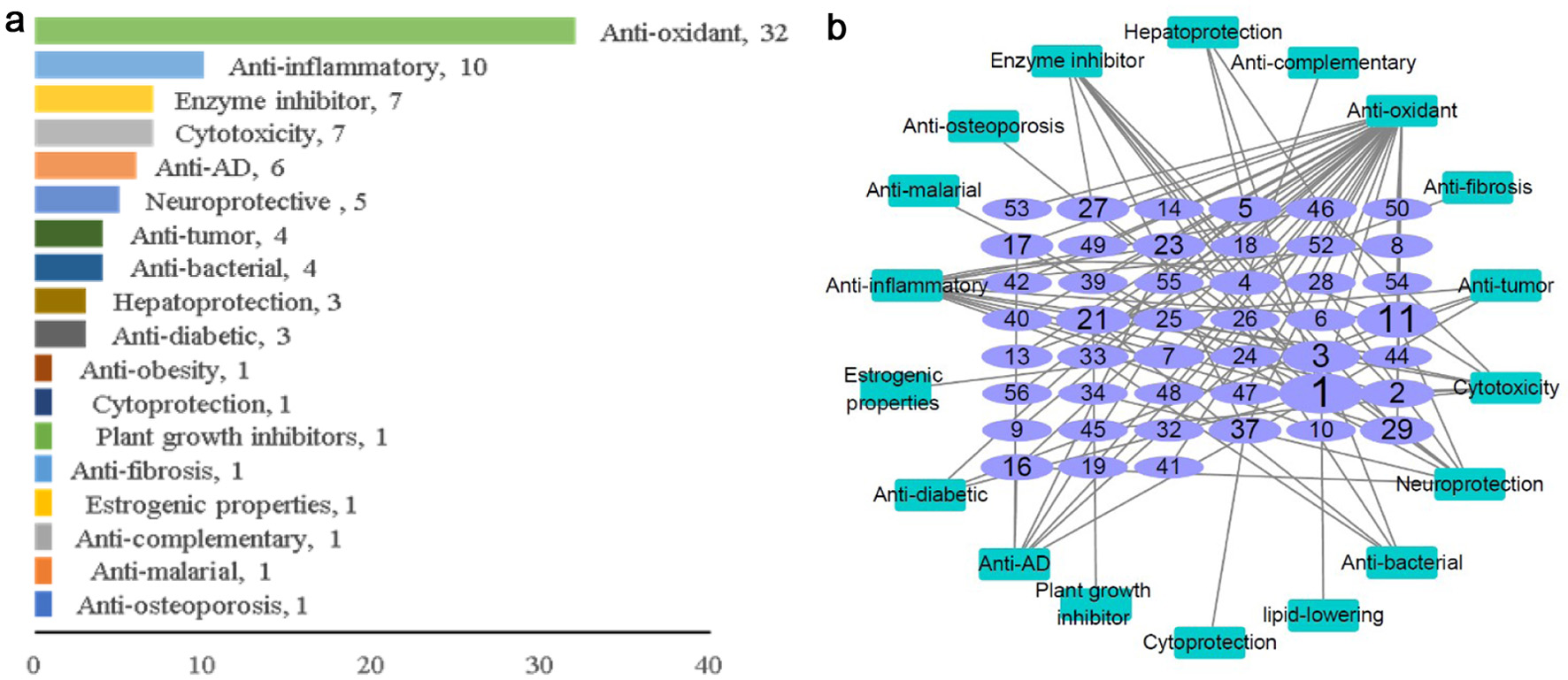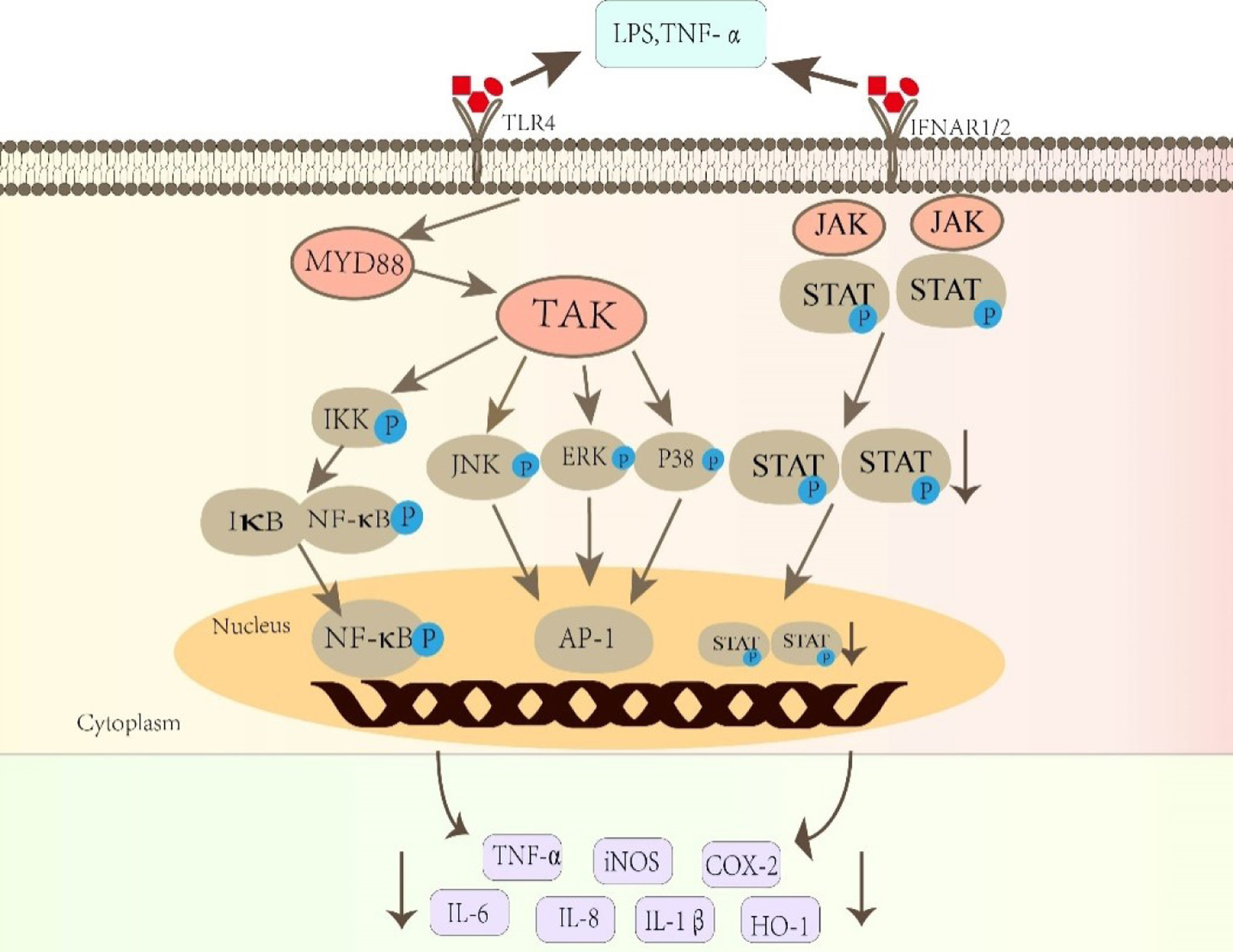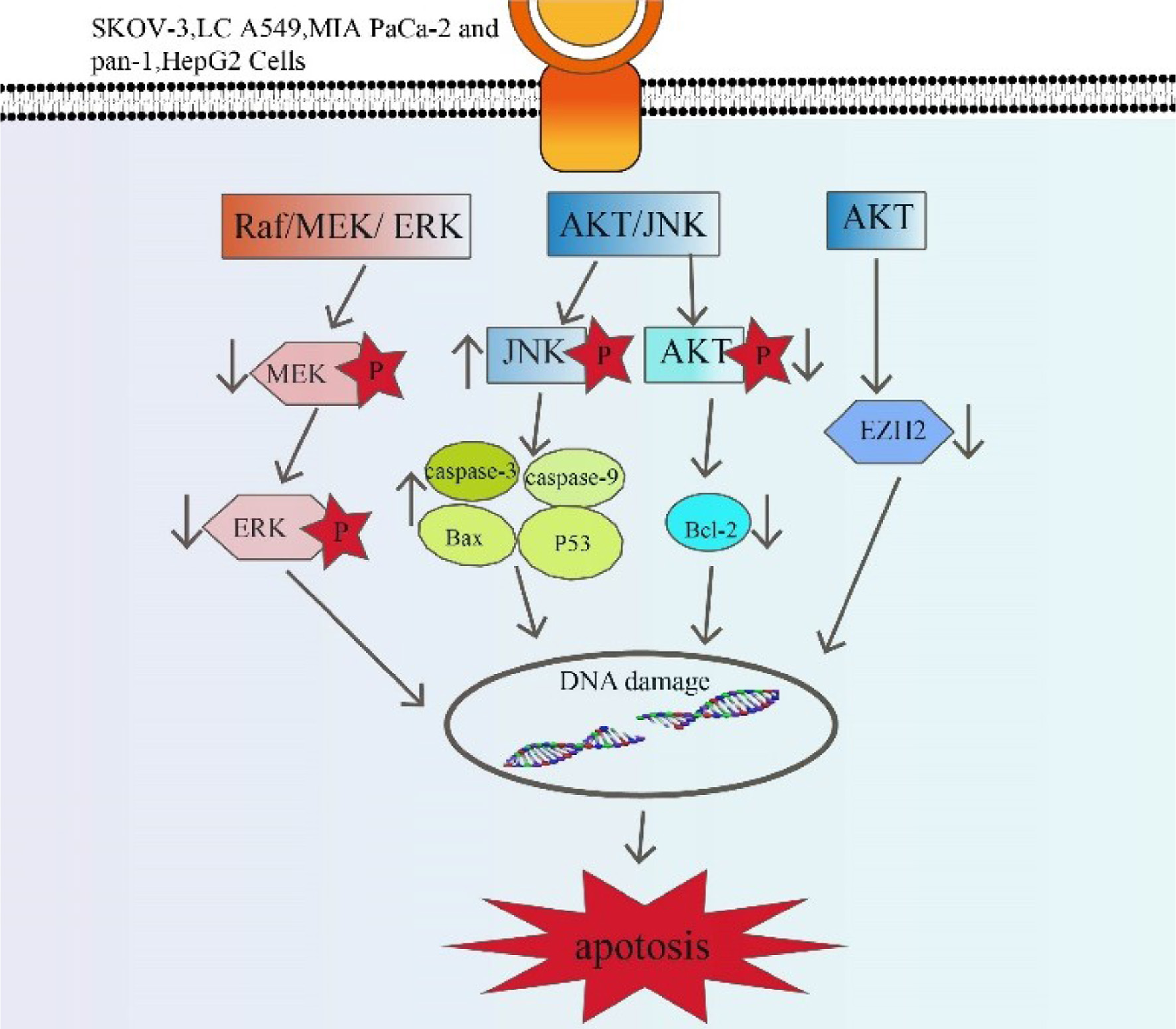
Figure 1. Structure of lignans in Patrinia.
| Journal of Food Bioactives, ISSN 2637-8752 print, 2637-8779 online |
| Journal website www.isnff-jfb.com |
Review
Volume 27, September 2024, pages 15-32
Lignans in Patrinia with various biological activities and extensive application value: A review
Figures




Tables
| Compound numbers | Name | Acitivity | Source | Ref. |
|---|---|---|---|---|
| “AD” stands for Alzheimer’s disease; “–” indicates that the activity of the compound is not reported in the reference. | ||||
| 1 | Pinoresinol | Cytotoxicity | P. scabiosaefolia | (Deveci et al., 2019; Zhang et al., 2020) |
| Anti-oxidant | (Deveci et al., 2019) | |||
| Hepatoprotection | (Kim et al., 2019) | |||
| Enzyme inhibitor | (Deveci et al., 2019; Salleh et al., 2019) | |||
| Anti-osteoporosis | (Jiang et al., 2019) | |||
| Anti-malarial | (Hashim et al., 2021) | |||
| Anti-inflammatory | (Yang et al., 2021) | |||
| Anti-AD | (Yu et al., 2019) | |||
| Anti-tumor | (Ning et al., 2019; Zhou et al., 2022) | |||
| Anti-diabetic | (Wikul et al., 2012) | |||
| 2 | Syringaresinol | Cytotoxicity | P. scabiosaefolia | (Lee et al., 2016; Ma et al., 2020; Zhang et al., 2020) |
| Enzyme inhibitor | (Salleh et al., 2019) | |||
| Anti-Inflammatory | (Chang et al., 2019; Kim et al., 2020) | |||
| Anti-oxidant | (Liu et al., 2021; Ma et al., 2020; Tran Thu et al., 2022) | |||
| 3 | Eudesmin | Cytotoxicity | P. scabiosaefolia | (Zhang et al., 2020) |
| Lipid-lowering | (Nam et al., 2018) | |||
| Anti-tumor | (Jiang et al., 2017; Yu et al., 2019) | |||
| Anti-biosis | (Yang et al., 2018) | |||
| Anti-inflammatory | (Li et al., 2020) | |||
| Enzyme inhibitor | (Park et al., 2021) | |||
| 4 | Medioresinol | Enzyme inhibitor | P.scabiosaefolia | (Salleh et al., 2019; Timalsina et al., 2021; Zhang et al., 2020) |
| Anti-complementary | (Hou et al., 2017) | |||
| 5 | (+)-Pinoresinol-4-O-β-D-glucopuranoside | Anti-oxidant Anti-diabetic Hepatoprotection | P.scabra | (Di et al., 2013; Youssef et al., 2020) |
| 6 | Syringaresinol mono-β-D-glucoside | Anti-oxidant | P. villosa | (Bai et al., 2018) |
| 7 | Pinoresinol-4,4′-di-O-β-D-glucopyranoside | Anti-oxidant | P. scabra | (Dinh Thi Huyen et al., 2022; Li et al., 2005) |
| Estrogenic properties | (Wang et al., 2011) | |||
| 8 | epipinoresinol | Anti-oxidant | P. scabiosaefolia | (Wang et al., 2019; Zhang et al., 2020) |
| Anti-inflammatory | (Yu et al., 2019) | |||
| 9 | (7R,7′R,7″S,8S,8′S,8″S)-4,4″-dihydroxy-3′,3,3″,5′-tetramethoxy-7,9′:7′,9-diepoxy-4′,8″-oxy-8,8′-sesquineolignan-7″,9″diol | Anti-oxidant | P. scabiosaefolia | (Song et al., 2011; Zhang et al., 2020) |
| 10 | Salicifoliol | Anti-inflammatory | P. scabiosaefolia | (Yang et al., 2013; Zhang et al., 2020) |
| 11 | Matairesinol | Cytotoxicity Anti-inflammatory | P. villosa | (Al-Sayed et al., 2020; Huang et al., 2021; Wu et al., 2021) |
| Anti-diabetic Hepatoprotection | (Yang and Wang, 2022) | |||
| Anti-tumor | (Lee et al., 2022; Mahajan et al., 2021) | |||
| Anti-oxidant | (Wu et al., 2021) | |||
| Neuroprotection | (Yi et al., 2019) | |||
| 12 | Matairesinol-4,4′-di-O-β-D-glucopyranoside | – | P. scabra | (Li et al., 2005) |
| 13 | (+)-Nortrachelogenin | Anti-fibrosis | P. scabiosaefolia | (Pemmari et al., 2018; Zhang et al., 2020) |
| Anti-oxidant | (Tebboub et al., 2018) | |||
| 14 | (−)-Nortrachelogenin | Anti-fungal | P. scabiosaefolia | (Lee et al., 2016; Li et al., 2003) |
| 15 | Nortracheloside | – | P. scabra | (Bai et al., 2017) |
| 16 | Patrinian A | Anti-AD Neuroprotection | P. villosa | (Liu et al., 2015) |
| 17 | Patrinian B | Anti-oxidant Anti-AD Neuroprotection | P. villosa | (Liu et al., 2015) |
| 18 | Styraxlignolide D | Anti-oxidant | P. scabra | (Di et al., 2013; Min et al., 2004) |
| 19 | Styraxlignolide E | Anti-oxidant | P. scabra | (Di et al., 2013; Min et al., 2004) |
| 20 | (2S,3S)-2α-(4″-hydroxy-3″-methoxybenzyl)-3β-(4′-hydroxy-3′-methoxybenzyl)-γ-butyrolactone | – | P. scabra | (Di et al., 2013) |
| 21 | Lariciresinol | Anti-tumor | P. scabra | (Gu et al., 2002; Ma et al., 2018) |
| Plant growth inhibitor | (Nakano et al., 2002) | |||
| Anti-fungal | (Bajpai, Shukla, et al., 2017; Hwang et al., 2011) | |||
| Anti-oxidant | (Bajpai, Alam, et al., 2017) | |||
| 22 | 4-[1-Ethoxyl-1-(4-hydroxy-3-methoxy)benzyl]methyl-2-(4-hydroxy-3-methoxy) benzyl-3-hydroxymethyl-tetrahydro-furan | – | P. scabra | (Bai et al., 2017) |
| 23 | Lariciresinol 4-O-β-D-glucopyranoside | Anti-AD Neuroprotection | P. villosa | (Liu et al., 2015) |
| Anti-inflammatory | (Li et al., 2015; Zou et al., 2021) | |||
| 24 | Lariciresinol 9-O-β-D-glucopyranoside | Anti-AD | P. villosa | (Liu et al., 2015) |
| 25 | Lariciresinol 4′-O-β-D-glucopyranoside | Anti-AD | P. villosa | (Liu et al., 2015) |
| Cytotoxicity | (Lee et al., 2016) | |||
| 26 | Tortoside B | Anti-AD | P. villosa | (Liu et al., 2015) |
| 27 | Tanegool | Neuroprotection | P. villosa | (Liu et al., 2015) |
| Anti-oxidant | (Lee et al., 2009) | |||
| Enzyme inhibitor | (Ohtsuki et al., 2012) | |||
| 28 | Tanegool-7′-methyl ether | Neuroprotection | P. villosa | (Liu et al., 2015) |
| 29 | Isolariciresinol | Anti-oxidant | P. villosa | (Liu et al., 2015) |
| Neuroprotection | (Cheng et al., 2020) | |||
| Anti-inflammatory | (Cho et al., 2001) | |||
| Enzyme inhibitor | (Lunder et al., 2019) | |||
| 30 | (−)-Isolariciresinol 4-β-D-glucopyranoside | – | P. scabiosaefolia | (Zhang et al., 2020) |
| 31 | (8S,7′R,8′S)-Isolarisiresinol 9′-O-β-D-glucopyranoside | – | P. scabiosaefolia | (Zhang et al., 2020) |
| 32 | 5-Methoxy isolariciresinol | Anti-oxidants | P. villosa | (Bai et al., 2018) |
| 33 | lyoniresinol | Anti-oxidant | P. villosa | (Bai et al., 2018; Koga et al., 2007) |
| Anti-fungal | (Moo-Puc et al., 2014) | |||
| 34 | (8R,7′S,8′R)-Isolarisiresinol 9′-O-β-D-glucopyranoside | Neuroprotection | P. scabiosaefolia | (Cheng et al., 2020; Zhang et al., 2020) |
| 35 | Patrinianeolignan I | – | P. scabiosaefolia | (Zhang et al., 2020) |
| 36 | Isodonoside VI | – | P. scabiosaefolia | (Zhang et al., 2020) |
| 37 | (7S,8R) Dihydrodehydrodiconiferyl alcohol 4-O-β-D-glucopyranoside | Antio-xidant | P. villosa | (He et al., 2014; Zhang et al., 2020) |
| Cytoprotection | (Wang et al., 2017) | |||
| Enzyme inhibitor | (Hong et al., 2014; Wu et al., 2012) | |||
| 38 | (7S,8R)-3′4,9′-Trihydroxy-4-methoxy-9-O-shikkyl-acyl-7,8-dihydrobenzofuran-1′-propyl lignan | – | P. scabiosaefolia | (Jiang et al., 2017) |
| 39 | (7R,8S)-3,3′,5-Trimethoxy-40,7-epoxy-8,5′-neolignan-4,9,9′-triol-9-β-D-glucopyranoside | Anti-oxidant | P. villosa | (Bai et al., 2018) |
| 40 | Massonianoside D | Anti-oxidant | P. villosa | (Bai et al., 2018) |
| 41 | (7R,8S)-Dihydrodehydrodiconiferyl alcohol 4-O-β-D-glucopyranoside | Anti-oxidant | P. villosa | (Bai et al., 2018) |
| 42 | (7R,8S)-glochidioboside | Anti-oxidant | P. villosa | (Bai et al., 2018) |
| 43 | 2,6,2′,6′-tetramethoxy-4,4′-bis (1,2-trans-2,3-epoxy-1-hydroxypropyl) biphenyl | – | P. villosa | (Xiang et al., 2017) |
| 44 | 2,6,2′,6′-tetramethoxy-4,4′-bis (2,3-epoxy-1-hydroxypropyl) biphenyl | Anti-inflammatory | P. villosa | (Liu et al., 2022; Xiang et al., 2017) |
| 45 | Patrineolignan A | Cytotoxic activity | P. scabra | (Di et al., 2013; Lee et al., 2020) |
| 46 | Patrineolignan B | Cytotoxic activity | P. scabra | (Di et al., 2013; Lee et al., 2020) |
| Anti-inflammatory | P. scabiosaefolia | (Lee et al., 2018; Yan et al., 2016) | ||
| 47 | (7R,8R)-threo-1-(4-hydroxy-3-methoxyphenyl)-2-{4-[(E)-3-hydroxy-1-propenyl]-2-methoxyphenoxy}-1,3-propanediol | Anti-oxidant | P. villosa | (Bai et al., 2018) |
| 48 | (7S,8R)-erythro-7,9,9′-trihydroxy-3,3′-dimethoxy-8-O-4′-neolignan-4-O-β-D-glucopyranoside | Anti-oxidant | P. villosa | (Bai et al., 2018) |
| 49 | (7S,8R)-erythro-guaiacyl-glycerol-β-O-4′-dihydroconiferyl ether-7-O-β-D-glucopyranoside | Anti-oxidant | P. villosa | (Bai et al., 2018) |
| 50 | (7S,8R)-erythro-guaiacyl-glycerol-β-O-4′-dihydroconiferyl ether-9′-O-β-D-glucopyranoside | Anti-oxidant | P. villosa | (Bai et al., 2018) |
| 51 | Erythro-(7S,8R)-Guaiacyl-glycerol-β-O-4′-dihydroconiferyl ether | – | P. villosa | (Xiang et al., 2017) |
| 52 | (1R,2S)-rel-1-(4′-hydroxy-3′-methoxyphenyl)-2-[400-(3-hydroxypropyl)-2″, 6″-dimethoxyphenoxy]-1,3-propanediol | Anti-oxidant | P. villosa | (Bai et al., 2018) |
| 53 | (7R,8R)-threo-7,9,9′-trihydroxy-3,3′-dimethoxy-8-O-4′-neolignan4-O-β-D-glucopyranoside | Anti-oxidant | P. villosa | (Bai et al., 2018) |
| 54 | (7R,8R)-threo-guaiacyl-glycerol-β-O-4′-dihydroconiferyl ether-9′-O-β-D-glucopyranoside | Anti-oxidant | P. villosa | (Bai et al., 2018) |
| 55 | (7R,8R)-threo-guaiacyl-glycerol-β-O-4′-dihydroconiferylether | Anti-oxidant | P. villosa | (Bai et al., 2018) |
| 56 | (7R,8S)-erythro-guaiacyl-glycerol-β-O-4′-dihydroconiferyl ether | Anti-oxidant | P. villosa | (Bai et al., 2018) |
| Compound numbers | Methods | IC50/EC50 (μM) | Source | Ref. |
|---|---|---|---|---|
| DPPH (1,1-diphenyl-2-picryl-hydrazyl radical); ABTS (2,2′-Azinobis-(3-ethylbenzthiazoline-6-sulphonate)); FRAP (ferric reducing antioxidant power); EDTA (Ethylenediaminetetraacetic acid); NBT (Nitro blue tetrazolium chloride); ROS (Reactive oxygen species); IC50 (Half maximal inhibitory concentration); EC50 (Concentration for 50% of maximal effect). | ||||
| 1 | DPPH, ABTS and CUPRAC assays | 9.72 ± 0.14 | Porodaedalea pini | (Deveci et al., 2019) |
| 18.45 ± 0.2 | ||||
| 11.15 ± 0.08 | ||||
| 2 | DPPH assay | 17.34 ± 0.44 | Portulaca oleracea L. | (Ma et al., 2020) |
| DPPH and ABTS assays | 25.30 ± 2.05, | Liparis nervosa | (Liu et al., 2021) | |
| 40.13 ± 2.27 | ||||
| 5 | FRAP and ABTS assays | 418.47µmol/g | Prunus domestica | (Youssef et al., 2020) |
| 1,091.3µmol/g | ||||
| 6 | DPPH, ABTS and FRAP assays | 9.9 ± 1.02 | Patrinia villosa Juss. | (Bai et al., 2018) |
| 12.7 ± 1.40 | ||||
| 19.94 ± 4.0 | ||||
| 7 | TBARS assay | 61.9 ± 3.9 | Pandanus tonkinensis | (Dinh Thi Huyen et al., 2022) |
| 8 | DPPH assay | 18.92 ± 0.06 | Lancea tibetica | (Wang et al., 2019) |
| 9 | ROS in (HBZY-1) cells | – | Euryale ferox Seeds | (Song et al., 2011) |
| 11 | A model of sepsis in vitro | The expression of antioxidant proteins Nrf2 and HO-1 was inhibited | – | (Wu et al., 2021) |
| 13 | DPPH assay | 38.6 ± 2.7 | Galactites elegans | (Lee et al., 2016) |
| 16 | DPPH, ABTS and FRAP assays | 27.5 ± 3.72 | Patrinia villosa Juss. | (Liu et al., 2015) |
| 0.3 ± 0.04 | ||||
| 27.53 ± 8.4 | ||||
| 17 | DPPH, ABTS and FRAP assays | 9.0 ± 1.91 | Patrinia villosa Juss. | (Liu et al., 2015) |
| 0.6 ± 0.08 | ||||
| 34.15 ± 8.8 | ||||
| 18 | DPPH assay | 278 | Styrax japonica | (Min et al., 2004) |
| 19 | DPPH assay | 194 | Styrax japonica | (Min et al., 2004) |
| 21 | DPPH assay | – | Rubia philippinensis | (Bajpai, Alam, et al., 2017) |
| 27 | Irradiated riboflavin/ (EDTA)/(NBT) assay system | 13.4 (EC50) | Magnolia fargesii | (Lee et al., 2009) |
| 29 | DPPH, ABTS and FRAP assays | 5.6 ± 0.16 | Patrinia villosa Juss. | (Liu et al., 2015) |
| 0.3 ± 0.06 | ||||
| < 5 | ||||
| 32 | DPPH, ABTS and FRAP assays | 46.1 ± 1.93 | Patrinia villosa Juss. | (Bai et al., 2018) |
| 5.1 ± 0.30 | ||||
| 143.34 ± 2.7 | ||||
| 33 | DPPH, ABTS and FRAP assays | 8.0 ± 0.81 | Patrinia villosa Juss. | (Bai et al., 2018) |
| 5.5 ± 0.04 | ||||
| 57.43 ± 7.1 | ||||
| 37 | ABTS assay | 193.85 mmol/l | Rosa soulieana | (Lunder et al., 2019) |
| 39 | DPPH, ABTS and FRAP assays | 5.3 ± 1.35 | Patrinia villosa Juss. | (Bai et al., 2018) |
| 0.2 ± 0.03 | ||||
| < 5 | ||||
| 40 | DPPH, ABTS and FRAP assays | >100 | Patrinia villosa Juss. | (Bai et al., 2018) |
| 15.1 ± 1.56 | ||||
| 18.36 ± 2.6 | ||||
| 41 | DPPH, ABTS and FRAP assays | >100 | Patrinia villosa Juss. | (Bai et al., 2018) |
| 9.9 ± 1.02 | ||||
| 42.77 ± 2.8 | ||||
| 42 | DPPH, ABTS and FRAP assays | 90.9 ± 2.41 | Patrinia villosa Juss. | (Bai et al., 2018) |
| 6.3 ± 0.53 | ||||
| 78.42 ± 4.5 | ||||
| 47 | DPPH, ABTS and FRAP assays | 15.4 ± 0.77 | Patrinia villosa Juss. | (Bai et al., 2018) |
| 0.5 ± 0.08 | ||||
| 20.95 ± 9.2 | ||||
| 48 | DPPH, ABTS and FRAP assays | >100 | Patrinia villosa Juss. | (Bai et al., 2018) |
| 25.1 ± 0.78 | ||||
| 16.49 ± 4.2 | ||||
| 49 | DPPH, ABTS and FRAP assays | >100 | Patrinia villosa Juss. | (Bai et al., 2018) |
| 23.2 ± 1.42 | ||||
| 8.26 ± 3.4 | ||||
| 50 | DPPH, ABTS and FRAP assays | >100 | P. villosa | (Bai et al., 2018) |
| 35.8 ± 0.94 | ||||
| 12.86 ± 4.8 | ||||
| 52 | DPPH, ABTS and FRAP assays | 70.1 ± 2.45 | Patrinia villosa Juss. | (Bai et al., 2018) |
| 26.2 ± 1.48 | ||||
| 12.86 ± 4.8 | ||||
| 53 | DPPH, ABTS and FRAP assays | >100 | Patrinia villosa Juss. | (Bai et al., 2018) |
| 15.5 ± 0.08 | ||||
| 15.28 ± 3.7 | ||||
| 54 | DPPH, ABTS and FRAP assays | 94.4 ± 2.38 | Patrinia villosa Juss. | (Bai et al., 2018) |
| 12.5 ± 0.83 | ||||
| 42.58 ± 4.9 | ||||
| 55 | DPPH, ABTS and FRAP assays | 58.3 ± 3.20 | Patrinia villosa Juss. | (Bai et al., 2018) |
| 27.4 ± 1.71 | ||||
| <5 | ||||
| 56 | DPPH, ABTS and FRAP assays | 33.7 ± 2.8 | Patrinia villosa Juss. | (Bai et al., 2018) |
| 12.7 ± 1.40 | ||||
| 206.88 ± 6.8 | ||||
| Compound numbers | Methods | IC50 (μM) | Source | Ref. |
|---|---|---|---|---|
| TNF (Tumor Necrosis Factor); LPS (Lipopolysaccharides); RAW264.7 (Mouse Mononuclear Macrophages Cells). | ||||
| 1 | TNF-α-induced MH7Acells | 6.25 ± 0.42 | Dendropanax dentiger | (Yang et al., 2021) |
| (fMLP/CB)-induced neutrophils | 6.81 ± 1.07 | Machilus japonica | (Li et al., 2020) | |
| LPS-stimulated production of TNF-α both in neutrophils and monocytes/macrophages | – | Forsythia | (Michalak et al., 2018) | |
| 2 | LPS-induced RAW264.7 cells | 26.56 ± 1.28 | Acanthopana sessiliflorus | (Kim et al., 2020) |
| LPS-induced RAW264.7 cells | 9.18 ± 1.90 | Neonauclea reticulata | (Chang et al., 2019) | |
| 3 | fMLF/CB-induced human neutrophils | 8.71 ± 0.74 | Machilus japonica | (Li et al., 2020) |
| 8 | LPS-stimulated production of TNF-α both in neutrophils | – | Forsythia | (Michalak et al., 2018) |
| and monocytes/macrophages | ||||
| 10 | LPS-induced RAW264.7 cells | 311.6 ± 14.1 | Lindera akoensis | (Yang and Wang, 2022) |
| 11 | LPS-stimulated production of TNF-α both in neutrophils and monocytes/macrophages | – | Forsythia | (Michalak et al., 2018) |
| fMLF/CB-induced human neutrophils | 2.7 ± 0.3 | Cupressus macrocarpa | (Al-Sayed et al., 2020) | |
| 23 | influenza A virus-induced pro-inflammatory | – | Isatis indigotica | (Li et al., 2015) |
| 29 | LPS-induced RAW264.7 cells | 123.8 | Coptis japonica | (Cho et al., 2001) |
| 44 | LPS-induced RAW264.7 cells | 10.62 ± 1.25 | Tripterygium regelii | (Liu et al., 2022) |
| 46 | LPS-induced RAW264.7 cells | 22.14 | Patrinia scabra | (Lee et al., 2018) |
| LPS-induced RAW264.7 cells | 17.8 | Patrinia scabra | (Yan et al., 2016) | |
| Compound numbers | Cancer cell line | IC50 (μM) | Source | Ref. |
|---|---|---|---|---|
| MCF-7 (Michigan Cancer Foundation-7); SK-MEL-2 (Human skin melanoma cells); A549/ H1975 (Human lung cancer cells); HCT-116 (Human colorectal adenocarcinoma cells); HepG2 (Human hepatocellular carcinoma cells); HeLa (Human cervical carcinoma cell line); MNK-45 (Human gastric cancer cells); H460 (Human large-cell lung cancer cells); SKM-1 (Human acute myeloid leukemia cells); NB4 (Human acute promyelocytic leukemia cells); Z-138 (mature B-cell acute lymphoblastic leukemia cell line); GIST-T1 (Human gastrointestinal stromal tumor cell line); H23 (Human non-small-cell lung cancer (NSCLC) cell line); T24 (Human urinary bladder cancer cells); A431 (human epidermoid carcinoma cell line); Du145 (human prostate cancer cell); MOLM-14 (Myeloid leukemia cells); PF382 (human malignant T lymphoblast); HEL (Human Erythroleukemia Cell Line); TMD8/ JVM-2 (Diffuse large B-cell lymphoma cell line); Namalwa (Human Burkitt’s lymphoma cells); U-2 OS (Human osteosarcoma cell line). | ||||
| 1 | MCF-7 | 21.08 ± 1.01µg/ml | Porodaedalea pini | (Deveci et al., 2019) |
| SK-MEL-2 | 37.96 | Euonymus alatus | (Lee et al., 2016) | |
| 2 | A549 | >100 | Eleutherococcus sessiliflorus | (Ma et al., 2020) |
| SK-MEL-2 | 23.24 | Euonymus alatus | (Lee et al., 2016) | |
| 3 | HCT-116 | 41.92 | Patrinia scabiosaefolia | (Zhang et al., 2020) |
| 11 | HepG2 | 15.1 μg/ ml | Cupressus macrocarpa | (Al-Sayed et al., 2020) |
| 23 | SK-MEL-2 | 42.86 | Euonymus alatus | (Lee et al., 2016) |
| 45 | HeLa MNK-45 | 1.8, 2.3 | Patrinia scabra | (Di et al., 2013) |
| H460, Hela, SKM-1, NB4, Z-138, GIST-T1 | – | Patrinia scabiosaefolia | (Jiang et al., 2017) | |
| 46 | HeLa MNK-45 | 2.7, 3.1 | Patrinia scabra | (Di et al., 2013) |
| H460, H1975, H23, T24, Hela, A431, Du145, HCT116, SKM-1, MOLM-14, PF382, HEL, TMD8, JVM-2, Namalwa, Z-138, U-2 OS, GIST-T1 | – | Patrinia scabiosaefolia | (Jiang et al., 2017) | |
| Activities | Compound numberss | Methods | IC50 (μM) | Source | Ref. |
|---|---|---|---|---|---|
| AChE (Acetylcholinesterase); BChE (Butyrylcholinesterase); MIC (Minimum Inhibitory Concentration); RBL-2H3 (Rat basophil leukemia cell line); HT-22 (Mouse hippocampal neurons cell); CCL4 (Carbon tetrachloride); MC3T3-E1 (Mouse embryonic osteoblast precursor cells). | |||||
| Enzyme inhibition | 1 | Anti-cholinesterase | AChE (13.73 ± 0.85%) | Porodaedalea pini | (Deveci et al., 2019) |
| BChE (80.02 ± 0.73%) | |||||
| lipoxygenase inhibitory | 15.2, | Piper stylosum | (Salleh et al., 2019) | ||
| 2 | lipoxygenase inhibitory | 24.0 | Piper stylosum | (Salleh et al., 2019) | |
| 3 | InhibitUDP-Glucuronosyltransferase 1A1 and 1A3 | 24.3, 26.6 | Magnoliae | (Park et al., 2021) | |
| 4 | lipoxygenase inhibitory | 18.5 | Piper stylosum | (Salleh et al., 2019) | |
| α-Amylase Inhibitory | – | Catunaregam spinosa | (Timalsina et al., 2021) | ||
| 27 | Glycogen Synthase Kinase-3β | 1 | Taxus yunnanensis | (Ohtsuki et al., 2012) | |
| 29 | Dipeptid peptidase 4 | 49.2 ± 7.0% (inhibition rate) | Abies alba | (Lunder et al., 2019) | |
| 37 | tyrosinase inhibitory | 15.92 ± 0.70 | Castanea henryi | (Wu et al., 2012) | |
| The inhibitory on the release of β-hexosaminidase from RBL-2H3 cells | 52.3 ± 0.9 | Pinus thunbergii | (Hong et al., 2014) | ||
| 1 | ameliorated memory impairment in dementia model induced by cholinergic blockade | 25 mg/kg | – | (Yu et al., 2019) | |
| 16 | Inhibition of self-induced Aβ aggregation | 57.57–65.53% (inhibition range) | Patrinina villosa | (Liu et al., 2015) | |
| 17 | |||||
| 23 | |||||
| 24 | |||||
| 26 | |||||
| Neuroprotective lignans | 11 | preventing LOHP-induced peripheral neuropathy | – | Forsythia | (Yi et al., 2019) |
| 16 | Neuroprotection | 50–100% (viability of cells) | Patrinina villosa | (Liu et al., 2015) | |
| 23 | |||||
| 27 | |||||
| 28 | |||||
| 29 | the neuroprotective activity against the injury of HT-22 cells induced by L-Glutamate in vitro | – | Selaginella picta | (Cheng et al., 2020) | |
| Anti-bacterial | 3 | inhibited the growth of H. pylori | – | – | (Yang et al., 2018) |
| 14 | Anti-Candida albicans | 25 μg/ml (MIC) | Partrinia scabiosaefolia | (Li et al., 2003) | |
| Anti-Escherichia coli O157 | – | – | (Lee et al., 2016) | ||
| 21 | Anti-pathogens Staphylococcus aureus KCTC1621 and Escherichia coli O157:H7. | 125∼250 μg/ml (MIC) | Rubia philippinensis | (Hwang et al., 2011) | |
| Anti-Candida albicans Anti-Trichosporon beigelii Anti-Malassezia furfur | 25, 12.5, 25 μg/ml (MIC) | Sambucus williamsii | (Bajpai, Shukla, et al., 2017) | ||
| 33 | Anti-trichomoniasis vaginalis | 17.57 | Maytenus phyllanthoides | (Moo-Puc et al., 2014) | |
| Hepatoprotection | 1 | Improve nonalcoholic fatty | – | Lysimachia vulgaris | (Kim et al., 2019) |
| liver disease | |||||
| 5 | Improve the hepatotoxicity model induced by CCl4 | 50 mg/kg | Prunus domestica | (Timalsina et al., 2021) | |
| 11 | Prevent hepatocyte apoptosis | – | (Yang and Wang, 2022) | ||
| Anti-diabetic | 5 | Inhibition of α-glucosidase | 48.13 μg/ml | Prunus domestica | (Timalsina et al., 2021) |
| 11 | Inhibition of DPPH-4 | – | – | (Yang and Wang, 2022) | |
| lipid-lowering | 3 | impairs adipogenic differentiation | – | – | (Nam et al., 2018) |
| Anti-osteoporosis | 1 | promotes MC3T3-E1 cell proliferation and differentiation | – | – | (Jiang et al., 2019) |
| Anti-malarial | 1 | Anti-malarial | 24.2 | Morinda morindoides | (Hashim et al., 2021) |
| Anti-complementary | 4 | complement inhibitors | 0.07–0.82 mM | Anchusa italica | (Hou et al., 2017) |
| Estrogenic properties | 7 | Estrogenic properties | – | Eucommia ulmoides | (Wang et al., 2011) |
| Anti-fibrosis | 13 | Attenuating on Bleomycin-Induced Dermal Fibrosis | – | Pinus sylvestris | (Pemmari et al., 2018) |
| plant growth inhibitors | 21 | plant growth inhibitors | – | Prosopis juliflora | (Nakano et al., 2002) |
| Cytoprotection | 37 | reduce acetaminophen-induced HepG2 cell injury | 30.5∼46.0% (inhibition rate) | Litsea cubeba | (Wang et al., 2017) |